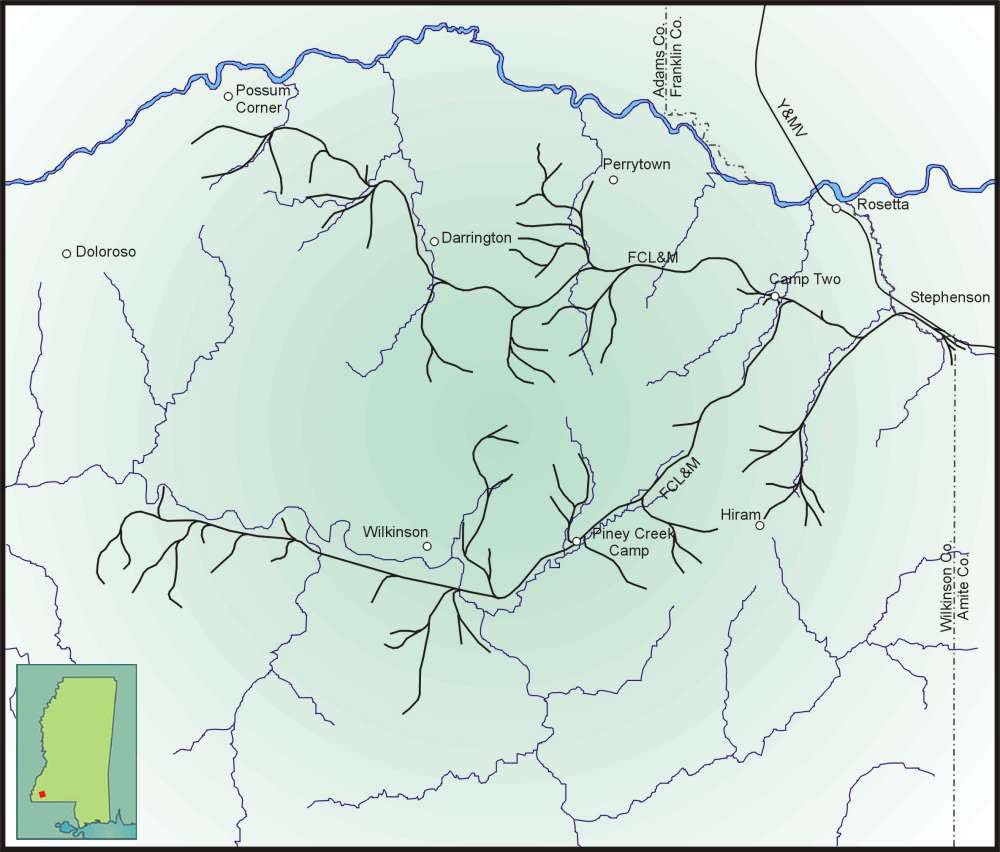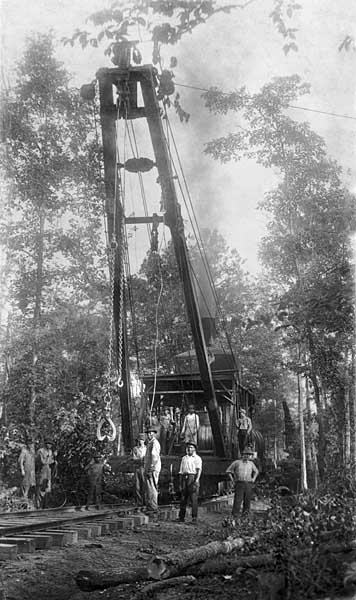
Foster Creek Lumber & Manufacturing Co.
Crosby Lumber & Manufacturing Co.
|
Standard Gauge, lb. rail Headquarters: Stephenson, MS later called Crosby, MS after 1935 Officers (): Years of Operation: 1916-1963 Miles Operated:
Locomotives Owned: |
Equipment
|
Click Map for Larger Version |
|
H.G.
Butler Foster
Creek Lumber Co.
One of the largest sawmills in southwestern Mississippi was
once located on the Yazoo & Mississippi Valley Railroad where it
crossed the Wilkinson-Amite County line. Like most of South
Mississippi, this part of the state was once covered in great expanses
of forest, consisting of mixed longleaf yellow pine, shortleaf pine,
and various species of hardwoods. The small town of Dayton grew up
after the completion of the railroad in 1884. H. G. Butler moved his
small sawmill from Knoxville, Mississippi, to a point about a mile
southeast of Dayton in 1900, and built a 36-inch gauge logging
railroad to supply this mill with logs. The area around the mill was
soon known as Butler’s Spur. In July 1903, the Butler mill,
timberland, and railroad was sold to D. H. Donaldson, who formed the
Foster Creek Lumber Company to operate the property. The sawmill at
Dayton operated until
late 1908, when it was finally shut down and the equipment sold off. Foster
Creek Lumber and Manufacturing Company
Even though the mill shut down, the Foster Creek Lumber Company
continued to exist as a timber buying company. After several years of
buying timber, the Foster Creek Lumber Company had accumulated about
52,000 acres of land in northern Wilkinson County and northwestern
Amite County. In early 1916, two brothers from Michigan heard about
the availability of this timber. George L. and Fred M. Stephenson were
involved in building several sawmills in Mississippi and Louisiana,
and traveled to Dayton
and met with T.B. McCurley, land agent of the old Foster Creek Lumber
Company, who took them out to look over the timber. The Stephenson’s
must have liked what they had seen. They went back north and
incorporated the Foster Creek Lumber and Manufacturing Company to take
over the holdings of the Foster Creek Lumber Company. The new company
was incorporated in the state of Wisconsin with a capital stock of
$1,500,000. Along with the Stephenson’s, other incorporators
included Edward J. Young and A.E. Proudfit of Madison, Wisc. On April
1, 1916, Foster Creek Lumber and Manufacturing Company purchased the
entire holdings of the Foster Creek Lumber Company. The new owners
quickly set out to build a new sawmill near the site of the old mill.
The site selected for the new mill was just south of the Y&MV,
right on the county line. The log pond was actually located in Amite
County, while the mill was to be built in Wilkinson County. Work on
clearing the mill site was completed by July 1916. The contract for
the construction of the sawmill was awarded to the Prescott Company of
Menominee, Michigan, by August 1916. Plans for the new double band
milled called for the entire mill to be electrically driven. This was
not a totally unique idea, as the Sumter Lumber Company at Electric
Mills, Mississippi, already had a large mill powered by electricity
that was built in 1911. Details of the new mill were released in the
American Lumberman: “The sawmill will be one of the largest in the South, embodying all the latest improvements in machinery, and will be electrically driven throughout, each machine being run by a separate motor. The
sawmill proper will be 70 by 248 feet with a timber dock extending 192
feet from the mill. A double drop sorter and a separate green lumber
sorter equipped with all of the latest time- and labor-saving devices
will be installed. The
equipment of the sawmill will consist of two 9-foot Prescott band
mills, an 8-foot Prescott vertical resaw, one five-block 44-inch
carriage and one three-block 44-inch carriage, with steam sets and
steam receders; two 72x8-inch edgers connected directly to motors;
slasher and air operated trimmer and a complete lath mill. The log
deck will be equipped with the latest improved kickers, stops, and
niggers of the heaviest construction.
The power house will be of brick and steel construction, 80 x
92 feet, as will be the fuel house, 30 x 72 feet. The power plant will
consist of eight 84 x 18 high pressure boilers with dutch oven fronts
and steel case marine settings. The power will be furnished by two 600
kilowatt and one 300 kilowatt General Electric high pressure
condensing turbines, one General Electric 10 kilowatt turbine driven
exciter, one General Electric 25 kilowatt motor driven exciter, one
Ingersoll-Rand barometric condenser with capacity for all the
turbines. A motor driven pump will take water from a creek 1,000 feet
from the mill. The condenser hot well will be provided with an
overflow into the mill pond. Also boiled feed water will be taken from
the hot well, allowing one pump to supply the entire plant.
Thirty-four motors will be utilized in the sawmill and ten in the
planning mill. The entire installation will be wired in conduit in the
latest improved manner. Edward
D. McKellar, representing the General Electric Company at New Orleans,
designed the power plant and the electrical installation. The planning
mill machinery will be furnished by P. B. Yates Machine Company,
Beloit, Wis., and the dry kilns by the L. Moore Dry Kiln Company,
Jacksonville, Fla.”
As construction on the mill
started, work was also underway on the new town near the mill. The
town was laid out parallel to the Y&MV Railroad, north of the
tracks. What was once the fields of T.B. McCurley was transformed into
a neat little town complete with modern homes and paved sidewalks. A
small commissary and post office was built near the railroad. Much of
the old town of Dayton was moved to the new town, which became known
as Stephenson. In October 1916, a charter was filed
for the incorporation of the new town of Stephenson. As January
1917 approached, work on the mill continued, and equipment for the
logging railroad began to arrive. A secondhand Pittsburgh-built 2-8-0
was purchased from Birmingham Rail and Locomotive Co. in December
1916. Weighing about 60 tons, this locomotive was numbered 6 by Foster
Creek. A 32-ton 2-truck Heisler locomotive was also purchased from a
lumber company in South Carolina in early 1917. This locomotive was
numbered 1. A number of log cars and a Clyde 4-line skidder also
arrived on the property by 1917. In addition, a combination ditcher
and log loader was purchased from the American Hoist and Derrick Co.
The mill was finally finished by July 1917 and was started up. It had
a capacity of approximately 170,000 board feet of lumber per day and
employed over 600. Shortly
after the mill was up and running, the Stephenson’s sold their
interest in the company in 1918. They were mainly interested in
building sawmills, not in the operation. Edward J. Young then
became president of the Foster Creek Lumber & Manufacturing
Company. As the mill was being finished up, work started on building the standard gauge logging railroad from the sawmill to the timber holdings. The railroad was built from the sawmill northwestward parallel to the Y&MV mainline for about a mile, where it swung southward to follow Tar Creek. One of the first areas to be logged by the company was southwest of Stephenson near the headwaters of Tar Creek near Hiram. Heisler Number 1 handled the loader while Number 6 switched at the mill. At that time those were the only engines owned by Foster Creek. The track at that time was too rough for the rod engine to go out on. In the very early days of logging, Foster Creek was logging with mule and ox teams and Lindsey eight-wheel log wagons. In addition to pine, a lot of hardwood was logged near Hiram. The company built a small log camp on this early railroad near the company demonstration farm that lasted about a year. In 1919, the logging railroad was greatly expanded. To tap into the heart of the Foster Creek timber holdings, a new branch of the railroad was built westward from Stephenson. Before this could be done, however, a steep ridge had to be crossed. A deep cut was dug through this ridge that lessened the grade somewhat, but it still remained the steepest hill on the railroad. Just west of this hill, near Dry Creek, the first large logging camp of Foster Creek was built in 1919. This camp, called Camp Two, remained the main camp of the company until it shut down during the Great Depression. A new 47-ton 3-truck Heisler was purchased in 1918 and numbered 3. Another Heisler was also purchased new the following year. Weighing in at 75 tons, this locomotive was numbered 4. In 1920, another large Heisler was added to the roster. This engine, Number 2, was the largest owned by the company. This 3-truck Heisler weighed 85 tons. Also during 1920, a second skidder was added by the company to supplement the one already in operation. This skidder was different than the first one purchased by the company in that it was a 2-line skidder, where the first skidder was a 4-line machine. This second skidder, which was also purchased from the Clyde Iron Works of Duluth, Minnesota, was called a bob-tail skidder because it only had a boom on one end, where the 4-line skidder had two large booms, one on each end.
In 1922, when Frank Moore moved to Stephenson to become a
regular sawyer on the left-hand rig, the mill consisted of two 9-foot
band mills, a 42-inch gang saw, a horizontal resaw, and a lath mill.
The left-hand side was the short side, while the right-hand side was
the long side. The mill was cutting between 165,000 and 175,000 feet a
day, running 10 hours a day. Once in a while, the mill would run 11
hours a day by the late 1920’s. The mill was cutting both pine and
hardwood on the same saws.
Construction on the main logging camp of Foster Creek Lumber
and Manufacturing Company at Camp Two started in 1919. To maintain the
locomotives used on the logging spurs, the camp had a small machine
shop and servicing facilities. A sand house and coal bin was located
in the camp. The camp also had a commissary, a hotel, a school, and a
doctor’s office. The store, which was run by Quitman McLemore, had a
meat market in the back. The camp was divided into two sections, one
for whites and the other for blacks. In the black section of the camp
there was a large building known as the barrelhouse, where there was
drinking, dancing, and gambling. Most of the people who worked in the
woods lived in Camp Two, including the logging superintendent,
loggers, and train crews. The small camp houses were all built at
Stephenson and loaded on log cars and shipped to the camp on the
logging railroad. In
1918, Mr. Clarence Jenkins was given the job as timekeeper and payroll
man, according to him simply because nobody else wanted the job. He
worked in the office at Camp Two, and lived in two camp houses there.
He remembered most of the houses in the camp were about 12 or 13 feet
wide by 24 or 26 feet long, well-built, and ceiled inside, and drop
siding outside. Jenkins had one shack 12x24 feet and a smaller one, a
front porch, and a screened back porch. He built a platform and placed
a large tank on top of it, and ran a gutter from the eve of the house
that caught the water so that he would have running water in the
kitchen sink. The logging superintendent had two shacks about 12 by 24
feet, a front and back porch, and a water tank for running water. Most
houses in the camp didn’t have running water. The houses were heated
by wood stoves, and most of the cooking was also done on the wood
stoves. Jenkins remembered that they had to take a bath in a #3 wash
tub. Rent for the houses like the one Jenkins lived in was $7.00 per
month. Other shacks that were about 12 feet by 12 feet rented for
$1.50 per month. Most families would have two or three of these
shacks. The hotel at the camp served breakfast, fixed the men’s
lunches in brown paper bags, and had their supper ready when they got
in. When the camp was first built room and board in the hotel was 65
cents a day, which was raised to $1 a day by 1921. There were two beds
in each of the sleep shacks near the engine facilities in the camp.
Usually single men would stay in these sleep shacks, while most
families had their own shacks. To get supplies to the store, the
company had a boxcar that was used about once a week to haul supplies
from the store in Stephenson to the camp. In the early 1920’s a
water tank was built at Camp Two to supply water for the locomotives,
loaders, and skidders. Prior to this time, water was most likely taken
right out of the creek that ran near the servicing facilities. To
supply water to this tank, Mr. Braswell, the logging superintendent,
dammed up a hollow next to the railroad up on the hill east of the
camp. A pipe was run from the dam to the water tank to keep it filled. Between
1920 and 1926, Foster Creek Lumber and Manufacturing Company was
logging the area west of Camp Two, extending as far west as Possum
Corner. The logging railroad was gradually extended westward from Camp
Two. By 1922, crews were logging the area near Turkey and Beaver
Creeks. In 1923 and 1924, they were working further down Beaver Creek,
near the community of Perrytown. The main line was built to Darrington,
where it turned north and followed along the west side of the east
fork of Crooked Creek for about two miles. At this point it turned
west. Crews logged the area west of Crooked Creek in 1925 and 1926.
When the camp was built, the track between there and the
sawmill was upgraded so that the rod engine, Number 6, could run all
the way to the camp. Gravel ballast was used to shore up the track.
After the track was upgraded, Number 6 usually hauled the log trains
from the camp over the big hill to the mill. The Heislers were used to
switch the log spurs and were all kept at the camp. The crews would
usually leave the camp early in the morning, around 4 o’clock, and
head out to the woods. Each crew would load a certain number of logs.
That was a day’s work, and they would then bring them in to the
camp. Sometimes they wouldn’t get back until way after dark, maybe 8
or 9 o’clock. They would leave the skidders and loaders where they
quit working for the night. They had a night watchman that would take
care of each one. Number Six was based in town and usually made one
round trip out to the camp and back a day. If the mill got short of
logs, Number Six would make two round trips.
Foster Creek Lumber and Manufacturing Company wasn’t the only
mill owned by E. J. Young. He, along with other Foster Creek
stockholders, also owned mills in British Columbia, Alabama, and
Louisiana. They owned the Black River Lumber Company at Willetts,
Louisiana. They incorporated the Wisconsin-Alabama Lumber Company on
June 21, 1917, and built a large mill at Sylacauga, Alabama. On April
12, 1924, they also purchased the Arkansas-Alabama Lumber Company at
Wetumpka, Alabama.
After the Arkansas-Alabama Lumber Company mill at Wetumpka was
purchased, two Shay locomotives were transferred to Stephenson in May
1924. Arkansas-Alabama Number 3, a 45-ton two truck Shay, became
Foster Creek Number 5. The other locomotive, a 65-ton three truck
Shay, became Foster Creek Number 8. Foster Creek sold 47-ton Heisler
Number 3 around 1925 to the E. L. Bruce Lumber Company of Memphis.
This locomotive, which was usually used on the steel gang, was
replaced by Shay Number 5. 32-ton Heisler Number 1, which usually
switched the mill, was sold to Southern Iron & Equipment Co., a
used equipment dealer, sometime before March 1927. When the
Wisconsin-Alabama Lumber Company mill at Sylacauga shut down around
1925, two locomotives from there were transferred to Stephenson, also.
Those two Heislers were 85-ton 3 truck Number 7 and 75-ton 3 truck
Number 9. In the late 1920’s, the rod engine, Number 6, had some
work done on it. Buddy Tucker, from the Illinois Central shops at
McComb, came over to Stephenson and put a new crown sheet in Number 6.
He also welded the side rod, and welded the frame. On its first trip
out, she broke the frame again and they cut the engine up for scrap.
The Number 7 then became the regular road engine. It was based at
Stephenson, and would make the trip out to Camp Two to bring in the
log trains at night.
Around 1925 or ’26, Foster Creek Lumber and Manufacturing
Company realized how much damage the skidders were causing to the
younger trees and stopped using the skidders. All logging was done
using mules and oxen after this time. By the late 1920’s, the
logging crews would leave a seed tree on every so many acres of land.
These trees would drop seed on the ground and help regenerate the
forest. These seed trees would frequently be hit by lightning, but
hopefully would scatter seed before dying. The skidders and logging
crews would bury the seed that had fallen the previous years too deep
for it to sprout.
In 1925, construction started on a new logging spur running
south and southwest from Camp Two. Known as the Piney Creek spur, this
line followed Mud Creek and Dry Creek until it reached the Buffalo
River. Just south of Wilkinson, this line eventually crossed the
river, and followed along the south side of the Buffalo River for
several miles. Numerous logging spurs were built off of this line. A
small log camp was built on this line soon after it was built. Known
as the Silver Creek Camp, this camp was located near the Silver Creek
Road. According to Luther Havard, who drove mules for Foster Creek,
this camp had a commissary that was run by Ray Tillery. About 20
families lived at this camp. This camp only lasted about a year.
In 1926, another small camp was built near the juncture of Mud
Creek and Piney Creek. This camp, known as Piney Creek Camp, was
slightly larger than Silver Creek Camp. Camp Two, however, remained
the main camp of the company until the end, and the locomotives were
always kept at Camp Two. Piney Creek Camp was mostly made up of camp
houses for loggers and their families so they would be closer to the
locations being logged. Piney Creek also had a commissary, which at
one time was run by Mr. McLemore. Several dozen portable camp houses
were located here. Approximately 25 or 30 families lived at Piney
Creek at one time. To care for the mules used in the logging, a feed
lot was built near Piney Creek Camp. In the last years of logging, Foster Creek Lumber and Manufacturing was logging south of the Buffalo River near Flat Lake and Ford’s Creek. The railroad at that time was about 27 or 28 miles long. The company would log a section of timber, then lease another section. In the last few months before the mill shut down, logging crews were logging some hardwood timber. They built a spur about six or seven miles into the river swamp. They logged the hardwood out and had the logs piled up about three and four deep all along the spur ready to be loaded when the mill shut down in early 1931. They pulled up the railroad and left those logs in there. Not long afterward, someone built a small groundhog mill there and cut up that hardwood into crossties. When the mill shut down, crews were also clearing the right-of-way and grading a new spur that left the main line near Flat Lake. It ran northward, crossing the Buffalo River, and towards the Hazlit Creek area. They were going to log the steep hills in that area, but the track was never laid.
As with many mills in the South, Foster Creek was severely hit
by the Depression after October 1929. The company was already heavily
mortgaged before that time. Starting in 1930, the mill ran on a
reduced schedule, maybe three or four days a week. The employees’
wages were also cut. The mill managed to struggle on until March 1,
1931, when the mill finally shut down for good. The Whitney National
Bank in New Orleans was forced to foreclose on a mortgage taken out by
Foster Creek on July 1, 1927 for $1,850,000, of which Foster Creek
still owed the bank $890,577.57. The bank sent a representative to
look after the property by the name of Mr. A. J. Gautreau, who moved
his family to Stephenson. Mr. Gautreau looked after the property and
made an inventory of all usable equipment on hand so the bank could
sell it. All of the railroad equipment was brought into Stephenson and
placed in storage.
In March 1932, the bank planned to sell the Foster Creek
holdings. Mr. Young thought that he would be able to buy back the
company for next to nothing. Mr. Wagner and Mr. Curtain, the sales
manager, went to Natchez to see about getting the mill started back
up. Mr. Young went down to New Orleans to work out a deal with the
bank. The bank refused his offer, and the deal fell through, however.
Instead, the property was sold to a non-operating company called the
Foster Creek Lumber Corporation on March 28, 1932 for a total of
$750,000. The Ingram-Day Lumber Company held a mortgage on some of the
timberlands once owned by Foster Creek, and foreclosed on the mortgage
and took possession of those lands. They offered to sell these lands
back to Mr. T. B. McCurley for next to nothing. Ingram-Day also took
possession of the unfinished lumber still at the Foster Creek mill. In
1932, they hired several former Foster Creek employees to finish the
lumber and ship it out. They started up the planing mill to finish the
lumber. After all of the lumber was shipped out, the operation was
shut down for good. The Illinois Central Railroad came in and pulled
up all of the rail on the Foster Creek logging railroads, as they
owned the rail and it was being leased to Foster Creek.
For some time, many people in the Stephenson area were out of
work. After March 1931, the powerhouse at the mill that supplied the
whole town with electricity was shut down, leaving the town without
power. T. B. McCurley was still employed to look after the timber
holdings. His boys rigged up a Model T Ford to run on the logging
railroad. They would go out and inspect the tracks about once a week.
They would inspect the bridges and all of the holdings and make sure
nobody stole anything. If they found something was missing, they would
report it to the sheriff. In the fall and winter, Red, Cletus, and
Leon McCurley would go hunting in the car. They would bring their bird
dogs and guns along when they went out to inspect the property.
Several lumbermen came to Stephenson to look over the Foster Creek
holdings. T. B. McCurley would give them the grand tour of the
property, including the timber holdings. One day, he had spent most of
the day showing the property to Mr. L. O. Crosby, Sr., a prominent
lumberman from Picayune, Mississippi. The two stopped to get a drink
of water from the thermos, when they looked around and discovered that
they were parked on the top of a high hill in the most beautiful
virgin timber around. Mr. Crosby turned to Mr. McCurley and said,
“Well, well, Mr. McCurley, I think you have sold a town and some
pine timber.” Crosby Lumber and Manufacturing Company
L. O. Crosby purchased the former Foster Creek Lumber and
Manufacturing holdings on January 13, 1934. Included in the deal were
the sawmill, railroad equipment, the town of Stephenson, and over
55,000 acres of timberland, estimated to contain about 350 million
feet of virgin Rosemary and shortleaf pine. Lucius Olen Crosby was
born on February 22, 1869, in Lincoln County, Mississippi. After
working in the sawmill business for several years, Crosby began
organizing several sawmills in Mississippi. He operated mills under
various names at Canton, Monroe, Hub, and Baxterville. In 1916 he
joined forces with Lamont Rowlands and formed the Goodyear Yellow Pine
Company at Picayune. The two also purchased the Rosa Lumber Company at
Picayune the following year. Crosby later acquired other mills at
Cybur, Blodgett, and Piave. Later on, his three sons, Robert Howell,
Hollis Hobson, and Lucius Osmond, joined him in the lumber business.
By 1934, only the Goodyear and Rosa mills in Picayune were still
operating. Crosby had a very good relationship with the International
Harvester Co. of Chicago, and through their financial backing was able
to purchase the Foster Creek property. To operate the new property at
Stephenson, the Crosby Lumber and Manufacturing Company was organized
in early 1934. L. O. Crosby served as president of the new company,
while Hollis served as vice president, Howell as treasurer, and L. O.,
Jr. as secretary. Hollis moved to Stephenson to run the new company as
general manager. Hollis had served as plant superintendent of the Rosa
mill in Picayune, and later as vice president of Goodyear Yellow Pine.
On April 4, 1934, the town of Stephenson was officially renamed
Crosby in honor of L. O. Crosby. The town was incorporated again and
T. B. McCurley was appointed mayor of the new town, a position he
served until his retirement in 1950 due to declining health. Crosby soon set out to completely renovate the mill and town. To superintend the mill renovation, they brought in J. R. Clark. Crosby also built several new houses in town. Many people moved to Crosby from Picayune and from the recently closed Virgin Pine Lumber Company at Piave, in Greene County, Mississippi, which cut out in November 1933. Much of the machinery was also moved from the Piave mill to be used at Crosby. The band mills from Piave were brought over to Crosby and used for spare parts. The mill at Piave was an all-electric double band mill with two 9 foot bands, the same as at Crosby. The mill at Piave was built by Filer & Stowell, while the mill at Crosby was a Prescott mill. Many of the electric motors were also brought over from the mill at Piave and used at Crosby. A 6 foot horizontal resaw was brought over from Piave and installed in the mill at Crosby to supplement the 2 band mills and Number One Wickes gang saw that was already in the mill. To get the mill up and running, the Crosby’s also had to replace some of the timbers in the mill that had deteriorated. They also had to level up the carriage trucks and carriage tracks in the mill.
In addition to renovating the mill, Crosby also added a creosote
plant and broom handle plant to the operation at Crosby in 1934. Work on
the creosote plant started in early 1934, and it was placed in operation
in July 1934. It was located east of the mill pond. The broom handle
plant was also added in 1934. Crosby had earlier operated a broom handle
mill in Picayune, where E. L. Robbins worked. He moved up to Crosby to
work in the broom handle plant, where he claimed they made over a
million handles a month for several years. For years a Mr. Smith was
head over the broom handle plant. Those working at the mill knew him as
“Broomhandle” Smith.
When Crosby took over the mill, he inherited all of the
locomotives that were used by Foster Creek. Instead of rebuilding the
logging railroad, however, he chose to convert to logging with trucks.
He brought three Shay locomotives from Piave and Picayune to Crosby to
switch the mill. He still had about a mile and a half of spurs
throughout the mill property, creosote plant, and interchange tracks.
The Foster Creek Heislers sat unused behind the mill for a year or so
before Crosby cut them up for scrap. Crosby did use 65-ton Shay Number 8
to switch the mill for a while. Crosby did sell 45-ton Shay Number Five
to the Graham County Railroad in North Carolina in 1938. The Shays
brought over from Piave and Picayune included 50-ton 2-truck Number 1,
60-ton 3-truck Number 11, and 50-ton 2-truck Number 15. For years,
Number 15 was used at the creosote plant, while Number 11 switched the
mill. Number 1 was used to unload logs at the log pond. Logs were
brought in on trucks and dumped next to logging railroad near the depot.
One of the large Shays would bring a cut of empty log flats and a loader
and crew would load the logs on the cars. The Shay would then set the
cars out on a siding or shove them down to the mill pond. The small Shay
would then spot them two or three at a time for the loader to unload
them and run the logs through the debarker and go on into the mill. For
a short time, Number 1 was used at the creosote plant, but it was deemed
too small to shove the timbers into the retorts.
For several years after purchasing the Foster Creek properties,
Crosby Lumber and Manufacturing continued to add to the timber holdings.
Tracts of timber were purchased as far away as Louisiana and Copiah and
Warren Counties, in Mississippi. Even though Crosby never operated the
Foster Creek logging railroad, a log train was operated over the
Illinois Central occasionally in the 1930’s. A locomotive and crew was
rented from the IC. Crosby’s contract loggers would haul logs to towns
along the IC such as Roxie, Hamburg, and Harriston, where the logs were
loaded on the log cars. Sometimes the train would run as far north as
Vicksburg.
After the mill at Crosby started up in 1934, the mill never did
shut down because of business conditions. One time the mill was forced
to shut down for two or three days because the weather got so cold it
froze the logs. The saws wouldn’t cut through them. During World War
II, many men employed at the Crosby mill quit to join the Armed Forces
or were drafted. Labor was getting difficult to find.
In order to supply the mill with logs, Crosby initiated a program
to manage the land on a sustained yield theory of forest regeneration
and cutting when the mill started in 1934. He hired Jimmy Clark to be
superintendent of logging and forestry. Clark hired a few forestry
people to manage the Crosby timberlands. Crosby hired crews to do the
logging, but hired contractors to deliver the logs to the mill.
After operating for more than 28 years, the decision was finally
made to close Crosby Lumber and Manufacturing Company in 1963. The mill
was finally shut down on November 12, 1963. In 1965, the Crosby Lumber
and Manufacturing timber holdings, totaling more than 152,000 acres,
were sold to the St. Regis Paper Company, who used the tracts of timber
to supply pulpwood for their huge paper mill at Ferguson, Mississippi,
just northeast of Monticello. The mill was sold in 1965 to Hood Lumber
Company, who reopened the mill for a short time. They purchased timber
under lease from St. Regis. Many employees left to find work at other
places, while others chose to retire when the mill closed. The Shay
locomotives used by Crosby were replaced by a Plymouth diesel switcher
in the late 1950’s. The Shays were then stored near the mill for quite
a while. Number One was scrapped at Crosby in 1954, while the others
survived. Number 15 was eventually sold to a railfan in Birmingham,
Thomas Lawson, Jr. Number 11 sat in Crosby for several years before it
was donated to the city of Natchez, where it was placed on display in a
local park in 1965.
|
||
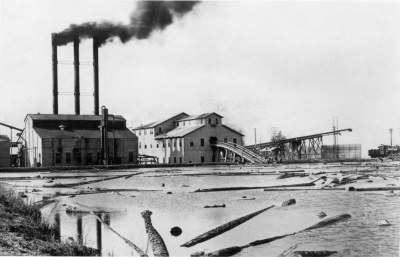
The Foster Creek mill at Stephenson as seen from across the man-made mill pond. |
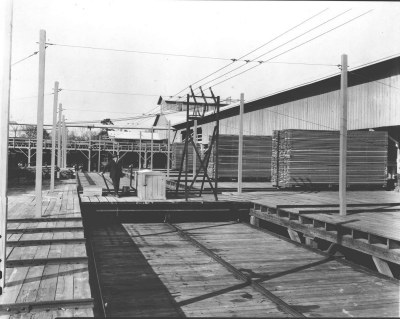
Electric transfer table was located off the green chain coming from the mill. |
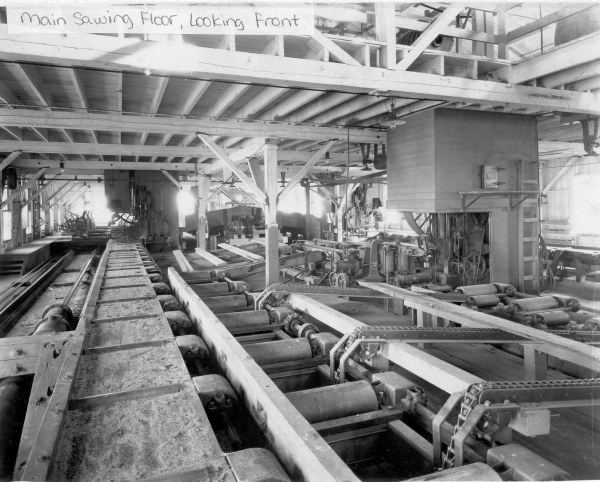 |
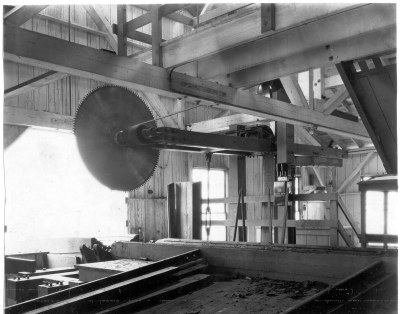
Cutoff saw at the top of the jack slip. |
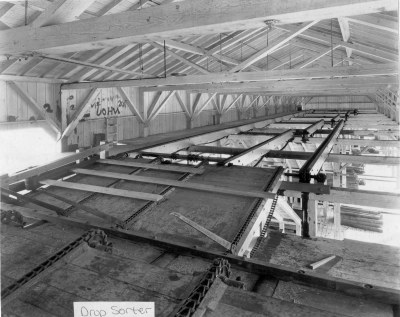
Drop sorter used to sort lumber coming from the green chain leaving the mill. |
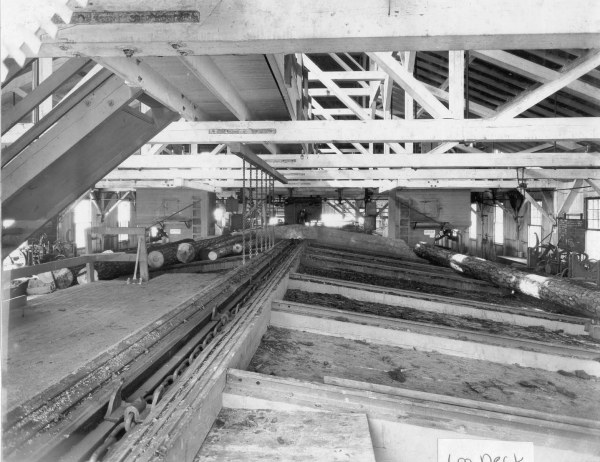
Main sawing deck looking into the mill from the jack slip. Long timbers were cut on the right side, while shorter lumber was cut on the band saw on the left. |
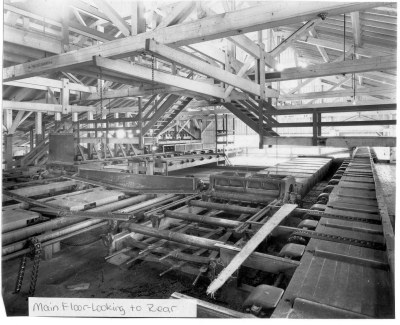
Main sawing floor looking towards the rear of the mill. |
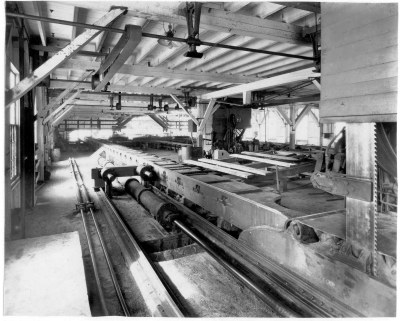
Feed used to move the carriage and the band saw blade at right. |
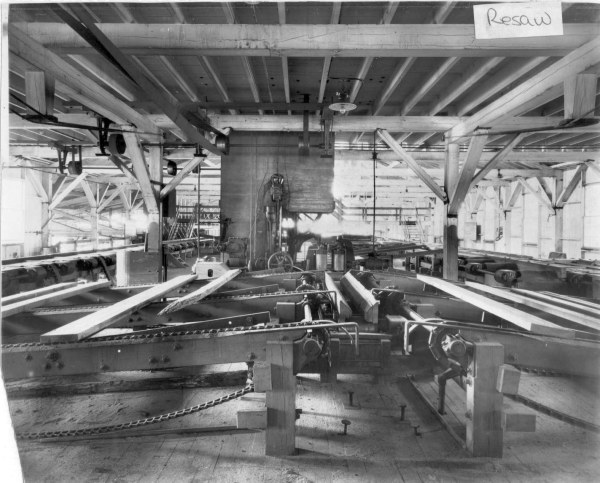
Resaw just to the rear of the main band saws. |
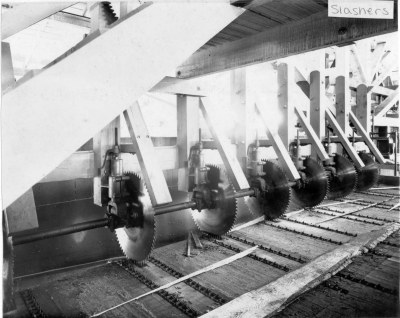
Slashers used to cut waste lumber. |
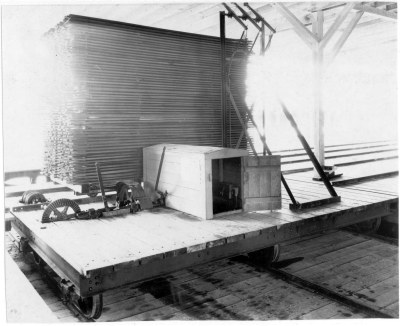
Electric lumber transfer table between the green chain and dry kilns. |
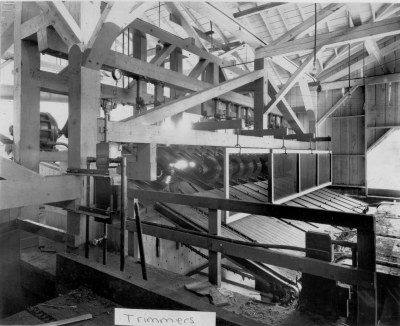
Trimmers used to trim boards to standard lengths. |
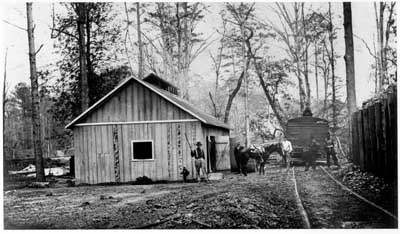
Machine shop and coal bin at Camp Two. |
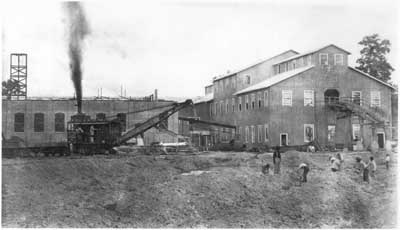
American loader being used to dig mill pond in 1916. |
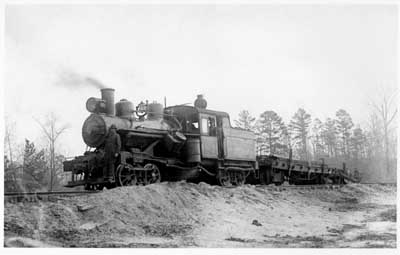
Heisler 3 on the work train with cars of rail used to construct the logging railroad. |
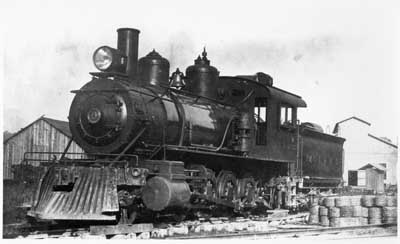
60-ton 2-8-0 Number 6 was bought secondhand by FCL&M in 1916. |
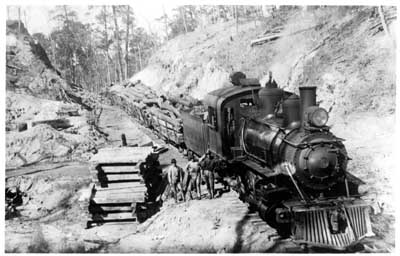
Number 6 tops the steep hill just east of Camp Two with a loaded log train. |
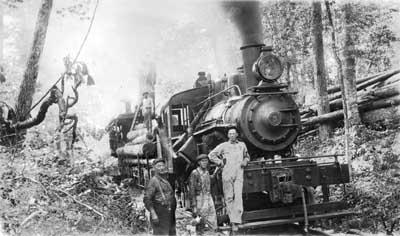
47-ton Heisler No. 3 and crew. |
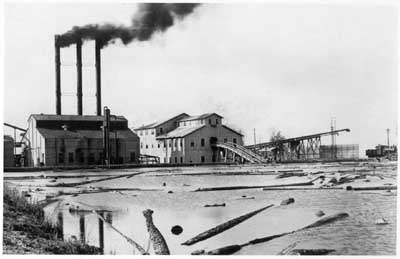 |
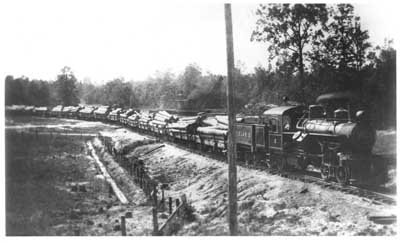
75-ton 3 truck Heisler No. 4 switching loads at Camp Two. |
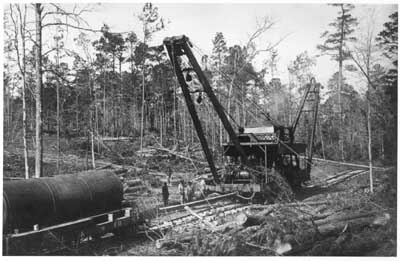
4-line Clyde skidder dragging logs to a logging spur. |
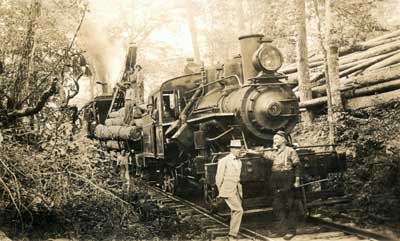
FCL&M owner Edward Young and a FCL&M engineer with Heisler No. 3. |
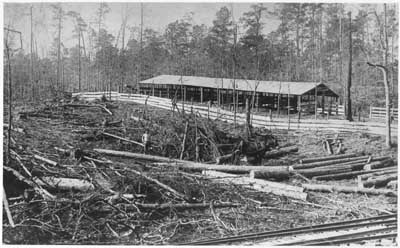
Stables were used to house horses and oxen used in logging operations. |
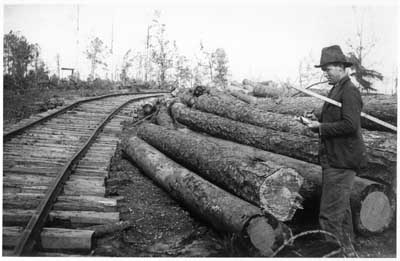
Log scaler John McCurley at work tallying logs along a logging spur. |
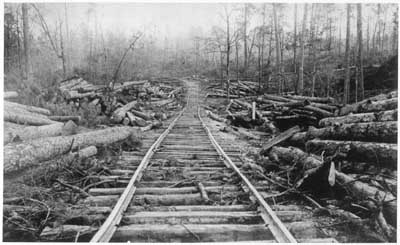
A typical rough logging spur of FCL&M. |
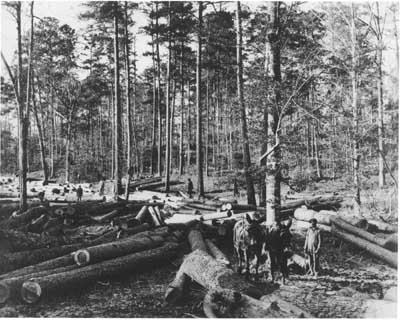
Mules being used to move logs at a bunching site near a log spur. |
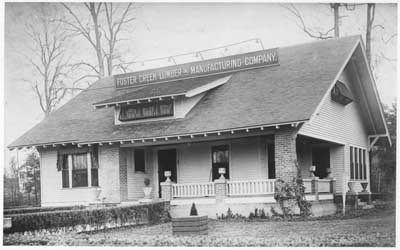
Foster Creek office in Stephenson still stands today and is used as the city offices. |
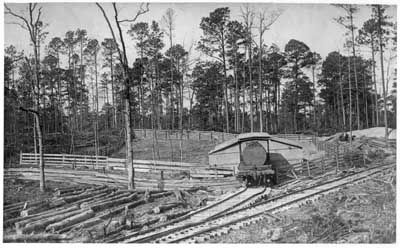
A water car is parked at the Foster Creek portable barn. |
|
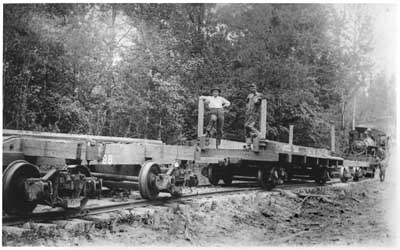
Foster Creek Heisler with the tracklaying train. |
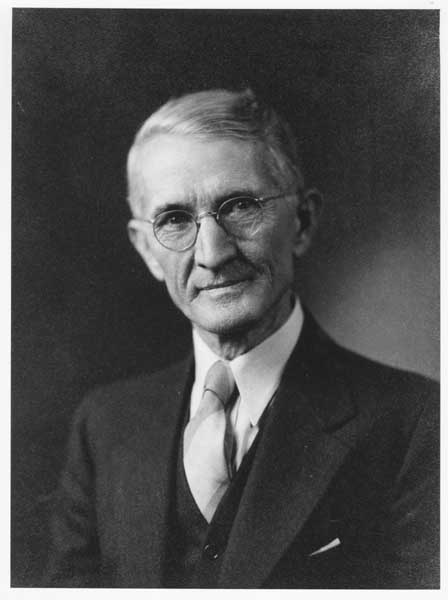
Thomas B. McCurley was responsible for getting Foster Creek Lbr & Mfg to locate in Stephenson, and later served as mayor of Stephenson. |
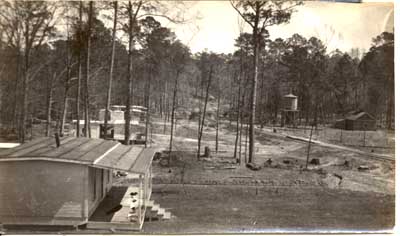
View at Camp Two looking east with the machine shop and water tank visible on the right. |
|
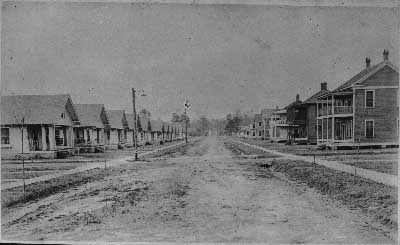
View looking west showing company houses in Stephenson. |
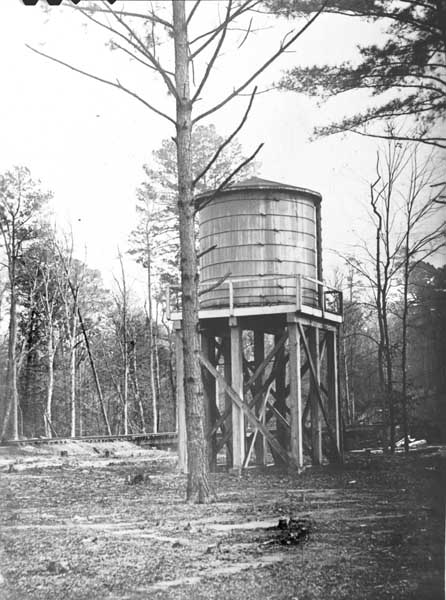
The water tank at Camp Two. |
|
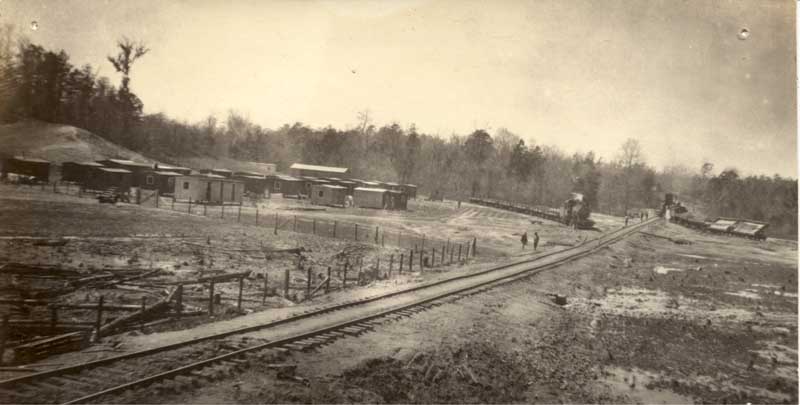
An unidentified rod engine is backed into a spur just beyond the black quarters at Camp Two while a Heisler is working with the tracklaying train just beyond. |
||
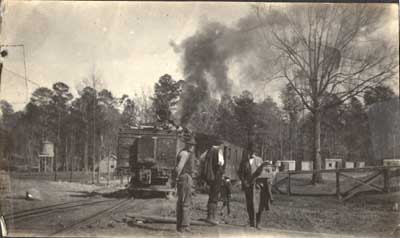
Company officials visit Camp Two. |
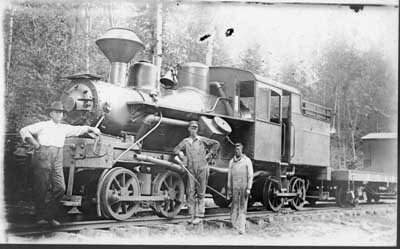
Heisler No. 1 weighed 32 tons and was bought secondhand in 1917. |
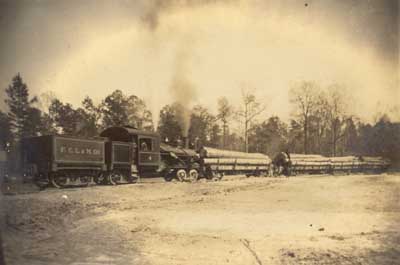
Heisler No. 4 switches loaded log cars. |

The new Y&MV depot at Stephenson in the 1920's. |

Number 6 at the mill pond. |
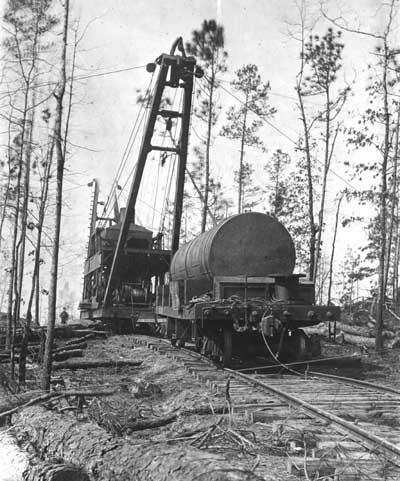
Foster Creek Clyde skidder and water car. |
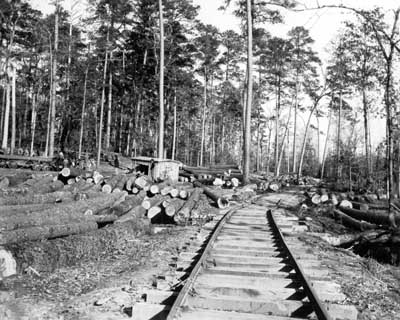
A log spur at a log landing in the early 1920's. |
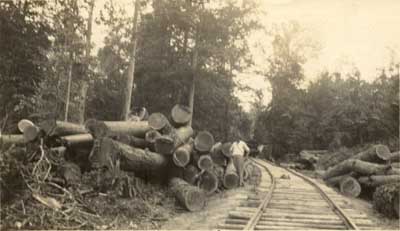
Another log spur with logs awaiting the loader. |
|
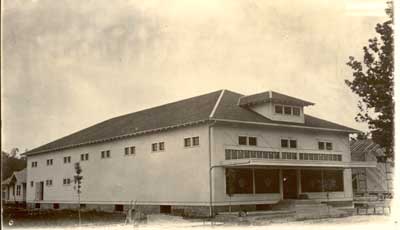
The new commissary at Stephenson. |
||
For more information contact Tony Howe at tonyhowe76@yahoo.com or David S. Price at davidsprice46@gmail.com
All content on Mississippi Rails website is copyrighted by us or the individual or institution noted on the image or accompanying text. Please contact us below for permission to use any image or information contained on this website. Mississippi Rails is not affiliated with any railroad.
©2009 Mississippi Rails
